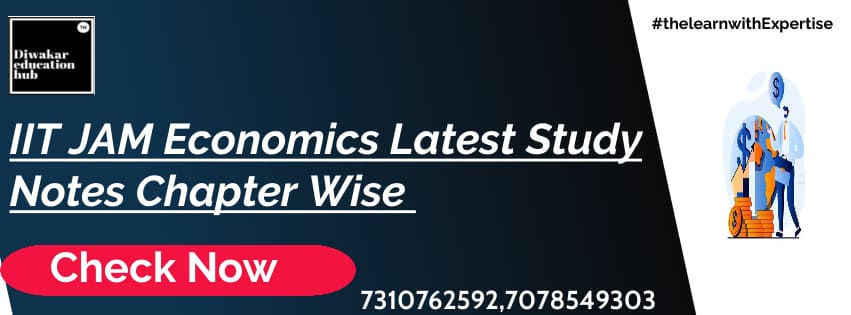IIT JAM Economics Latest Study Notes Chapter /Subject Wise As Per Updated Syllabus

IT JAM Economics is an entrance exam for admission to Master of Science (M.Sc.) programs in Economics at the Indian Institutes of Technology (IITs) and other Indian institutions. It was introduced in 2021 to expand the scope of the IIT JAM exam.The IIT JAM Economics syllabus covers a wide range of topics in economics, mathematics, and statistics here are chapter Wise Study Notes of IIT JAM Economics.
Here are Important Information for IIT JAM Economics
Sure! Here’s the important information about IIT JAM Economics in a table format:
| Feature | Information |
|---|---|
| Exam Type | Computer Based Test (CBT) |
| Duration | 3 Hours |
| Total Marks | 100 |
| Number of Questions | 60 (Multiple Choice) |
| Sections | |
| Section A – Microeconomics | 20 Questions |
| Section B – Macroeconomics | 20 Questions |
| Section C – Mathematics & Statistics | 20 Questions |
| Marking Scheme | |
| Sections A & B | |
| 10 Questions (1 Mark each) | Negative marking (1/3 mark deducted for incorrect answer) |
| 10 Questions (2 Marks each) | Negative marking (2/3 mark deducted for incorrect answer) |
| Section C – Mathematics & Statistics | |
| 10 Questions (1 Mark each) | No negative marking |
| 10 Questions (2 Marks each) | No negative marking |
IIT JAM Economics Chapter Wise Study Notes Include All [5 Subjects]
Here are Chapter Wise Detailed Study Notes Chapter Wise Design By Expert Faculties of Diwakar Education Hub those Having Experience More then 10 year in Economics Field
| Subject /Chapter Name | Link |
|---|---|
| Chapter -1 Microeconomics | https://wa.link/tgiotk |
| Chapter –2 Macroeconomics | https://wa.link/tgiotk |
| Chapter –3 Statistics for Economics | https://wa.link/tgiotk |
| Chapter –4 Indian Economy | https://wa.link/tgiotk |
| Chapter –5 Mathematics for Economics | https://wa.link/tgiotk |
IIT JAM Economics Latest Syllabus 2025
Here is Detailed Syllabus for IIT JAM Economics 2025 Chapter Wise
| Chapter -1 Microeconomics | Consumer theory: Preference, utility and representation theorem, budget constraint, choice,demand (ordinary and compensated), Slutsky equation, revealed preference axioms Theory of production and cost: Production technology, isoquants, production function withone and more inputs, returns to scale, short run and long run costs, cost curves in the shortrun and long runGeneral equilibrium and welfare: Equilibrium and efficiency under pure exchange and production, welfare economics, theorems of welfare economics Market structure: Perfect competition, monopoly, pricing with market power, price discrimination (first, second and third), monopolistic competition and oligopoly Game theory: Strategic form games, iterated elimination of dominated strategies, Nash equilibrium, mixed extension and mixed strategy Nash equilibrium, examples: Cournot,Bertrand duopolies, Prisoner’s dilemma Public goods and market failure: Externalities, public goods and markets with asymmetric information (adverse selection and moral hazard) |
| Chapter -2 Macroeconomics | Macroeconomics National income accounting: Structure, key concepts, measurements, and circular flow of income – for closed and open economy, money, fiscal and foreign sector variables – concepts and measurements Behavioural and technological functions: Consumption functions – absolute income hypothesis, life-cycle and permanent income hypothesis, random walk model of consumption, investment functions – Keynesian, money demand and supply functions, production functionBusiness cycles and economic models (closed economy): Business cycles-facts andfeatures, the Classical model of the business cycle, the Keynesian model of the business cycle, simple Keynesian cross model of income and employment determination and the multiplier (in a closed economy), IS-LM Model, Hicks’ IS-LM synthesis, role of monetary and fiscal policies |
| Chapter –3 Statistics for Economics | Probability theory: Sample space and events, axioms of probability and their properties, conditional probability and Bayes’ rule, independent events, random variables and probability distributions, expectation, variance and higher order moments, functions of random variables, properties of commonly used discrete and continuous distributions, density and distribution functions for jointly distributed random variables, mean and variance of jointly distributed random variables, covariance and correlation coefficients |
| Chapter –4 Indian Economy | Indian economy before 1950: Transfer of tribute, deindustrialization of India Planning and Indian development: Planning models, relation between agricultural and industrial growth, challenges faced by Indian planning Indian economy after 1991: Balance of payments crisis in 1991, major aspects of economicreforms in India after 1991, reforms in trade and foreign investment Banking, finance and macroeconomic policies: aspects of banking in India, CRR and SLR,Financial sector reforms in India, fiscal and monetary policy, savings and investment rates in India Inequalities in social development: India’s achievements in health, education and other social sectors, disparities between Indian States in human development Poverty: Methodology of poverty estimation, Issues in poverty estimation in India India’s labour market: unemployment, labour force participation rates |
| Chapter –5 Mathematics for Economics | Preliminaries and functions: Set theory and number theory, elementary functions: quadratic,polynomial, power, exponential, logarithmic, functions of several variables, graphs and levelcurves, convex set, concavity and quasiconcavity of function, convexity and quasi-convexity offunctions, sequences and series: convergence, algebraic properties and applications, complexnumbers and its geometrical representation, De Moivre’s theorem and its application Differential calculus: Limits, continuity and differentiability, mean value theorems, Taylor’s theorem, partial differentiation, gradient, chain rule, second and higher order derivatives:properties and applications, implicit function theorem, and application to comparative staticsproblems, homogeneous and homothetic functions: characterisations and applications Integral calculus: Definite integrals, fundamental theorems, indefinite integrals and applicationsDifferential equations, and difference equations: First order difference equations, first orderdifferential equations and applications Linear algebra: Matrix representations and elementary operations, systems of linear equations:properties of their solution, linear independence and dependence, rank, determinants,eigenvectors and eigenvalues of square matrices, symmetric matrices and quadratic forms,definiteness and semidefiniteness of quadratic forms Optimization: Local and global optima: geometric and calculus-based characterisations, andapplications, multivariate optimization, constrained optimization and method of Lagrangemultiplier, second order condition of optima, definiteness and optimality, properties of value function: envelope theorem and applications, linear programming: graphical solution, matrix formulation, duality, economic interpretation. |
How to Select Best Study Notes for IIT JAM Economics
Content and Coverage:
- Syllabus Alignment: Ensure the notes cover the entire IIT JAM Economics syllabus, including Microeconomics, Macroeconomics, Mathematical Methods for Economics, Statistics for Economics, and Econometrics. Check for a balanced coverage across all sections.
- Depth and Clarity: Look for notes that explain concepts clearly and concisely, but with enough depth for exam-level understanding. Avoid overly simplistic or excessively detailed notes.
- Accuracy: Double-check the credibility of the source. Ideally, choose notes from established coaching institutes, reputed authors, or toppers who’ve excelled in the exam.
Format and Learning Style:
- Presentation: Opt for well-structured notes with proper headings, subheadings, bullet points, and flowcharts for better organization and information retrieval.
- Visuals: Look for notes that incorporate diagrams, graphs, and other visuals to enhance understanding, especially for complex concepts.
- Your Preference: Consider your learning style. Do you prefer concise points or more elaborate explanations? Do visuals aid your learning? Choose notes that suit your style.
Additional Features:
- Practice Questions: Look for notes that include practice questions or solved examples for each topic. This helps solidify understanding and identify areas needing improvement.
- Previous Year Papers: If available, notes with analysis of previous years’ IIT JAM Economics question papers can be invaluable for understanding exam trends and question types.
- Topic-wise Analysis: Notes with a breakdown of weightage for each topic can help strategize your study plan and prioritize sections.
Finding the Right Source:
- Coaching Institutes & Online Courses: Reputable coaching institutes often sell study materials or offer online courses with comprehensive notes.
- IIT JAM Toppers: Some toppers might publish their notes or share their strategies online. However, ensure the information is reliable and up-to-date.
- Subject Matter Experts: Look for notes compiled by economics professors or authors of renowned IIT JAM preparation books.
- Online Resources: Free or paid resources might be available online, but scrutinize them carefully for accuracy and completeness.
IIT JAM Economics Exam Pattern
The IIT JAM Economics exam pattern is designed to assess your knowledge of core economic concepts, mathematical and statistical methods, and their application. Here’s a breakdown:
Key Features:
- Mode: Computer Based Test (CBT)
- Duration: 3 Hours
- Total Marks: 100
- Number of Questions: 60 (All Multiple Choice)
- Sections: 3 (Mandatory to attempt all)
Section-wise Breakup:
- Section A: Microeconomics (20 Questions)
- Focuses on core microeconomic principles like demand and supply, consumer behavior, market structures, and general equilibrium analysis.
- Section B: Macroeconomics (20 Questions)
- Covers topics related to national income accounting, inflation, unemployment, economic growth, monetary and fiscal policy.
- Section C: Mathematics & Statistics (20 Questions)
- Assesses your understanding of mathematical methods (differential/integral calculus, matrix algebra, optimization) and statistical tools (descriptive statistics, probability, hypothesis testing, regression analysis) relevant to economics.
Marking Scheme:
- Section A & B:
- 10 Questions (1 Mark each)
- Negative marking: 1/3 mark deducted for incorrect answer.
- 10 Questions (2 Marks each)
- Negative marking: 2/3 mark deducted for incorrect answer.
- 10 Questions (1 Mark each)
- Section C:
- 10 Questions (1 Mark each)
- 10 Questions (2 Marks each)
- No negative marking for any questions in this section.
Tips for the Exam Pattern:
- Understand the weightage: Since each section carries equal weightage (33.33%), ensure a balanced preparation across all areas.
- Practice time management: With 60 questions in 3 hours, you get 3 minutes per question on average. Practice solving questions within this timeframe to improve speed and accuracy.
- Strategize for negative marking: For sections A & B, a calculated guess might be beneficial to avoid losing a significant portion of marks due to negative marking. However, avoid random guessing for sections with no negative marking.
Frequently Asked Questions IIT JAM Economics
Who can appear for the IIT JAM Economics exam?
Candidates with a Bachelor’s degree in Economics, Mathematics, Statistics, or any allied discipline from a recognized university can apply. Final year students are also eligible..
Q: What are the main topics covered in the IIT JAM Economics syllabus?pen_spark
The syllabus covers Microeconomics, Macroeconomics, Mathematical Methods for Economics, Statistics for Economics, and Econometrics.
Q: How can I prepare effectively for the IIT JAM Economics exam?pen_spark
Here are some tips:
- Start early and create a study schedule.
- Familiarize yourself with the syllabus and exam pattern.
- Focus on understanding core concepts, not just memorizing.
- Solve previous years’ question papers and mock tests.
- Practice time management for the exam.
- Use reliable study materials like coaching notes, recommended books, and online resources.
.
Q: Where can I find good study notes for IIT JAM Economics?
A: You can find notes from coaching institutes, online courses, toppers’ resources, or subject matter experts. Look for notes that cover the syllabus comprehensively, explain concepts clearly, and offer practice questions.
| IIT JAM Economics Syllabus | IIT JAM Economics Books |
| IIT JAM Economics PYQ | IIT JAM Economics Exam Pattern |

